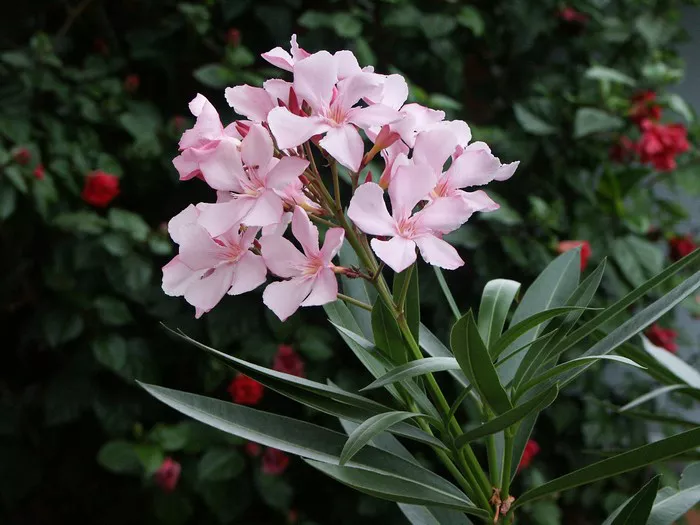In the world of flora, beauty often conceals danger. While many plants captivate us with their vibrant colors and enchanting fragrances, some of these natural beauties harbor deadly secrets. These plants, though visually appealing, contain toxins that can pose severe health risks, and in extreme cases, can be fatal to humans. Understanding these dangerous plants is essential, particularly for those with children or pets, to prevent accidental poisonings. This article delves into six such beautiful yet perilous plants, exploring their characteristics, the toxins they contain, and the effects these toxins can have on human health.
1. Oleander (Nerium oleander)
Oleander is a stunning evergreen shrub known for its beautiful flowers, which can be red, pink, yellow, or white. Native to the Mediterranean region, oleander is widely cultivated for ornamental purposes in gardens and parks. However, every part of this plant is highly toxic.
Toxins and Effects:
Oleander contains cardiac glycosides, specifically oleandrin and neriine, which interfere with the electrolyte balance within heart cells. Ingesting any part of the plant, even in small quantities, can lead to severe symptoms such as nausea, vomiting, abdominal pain, diarrhea, irregular heartbeats, and, in extreme cases, death due to cardiac arrest.
Precautions:
Avoid planting oleander in areas accessible to children and pets. Wear gloves when handling the plant, and wash hands thoroughly afterward.
2. Deadly Nightshade (Atropa belladonna)
Atropa belladonna, commonly known as deadly nightshade, is a perennial herbaceous plant that produces sweet, cherry-like berries and beautiful bell-shaped flowers. Despite its alluring appearance, belladonna is one of the most toxic plants found in the wild.
Toxins and Effects:
The plant contains tropane alkaloids, including atropine, scopolamine, and hyoscyamine. These alkaloids can cause a range of symptoms, from dilated pupils, sensitivity to light, blurred vision, and tachycardia to hallucinations, convulsions, and death. Even a small dose of its berries or leaves can be lethal to humans.
Precautions:
Avoid ingesting any part of the plant and be cautious when hiking in areas where belladonna grows. Educate children about the dangers of eating unknown berries.
3. Castor Bean (Ricinus communis)
The castor bean plant, with its striking foliage and spiky seed pods, is an attractive addition to many gardens. However, the seeds of this plant contain one of the most potent toxins known to humans: ricin.
Toxins and Effects:
Ricin is a highly potent protein that inhibits protein synthesis within cells, leading to cell death. Ingesting even a single castor bean can cause severe abdominal pain, vomiting, diarrhea, and dehydration. In more severe cases, it can lead to liver and kidney failure and death.
Precautions:
Avoid planting castor bean plants if there are children or pets around. Handle seeds with care, and never ingest them. Educate others about the dangers of this plant.
4. Water Hemlock (Cicuta maculata)
Water hemlock is often mistaken for other harmless plants due to its pretty, white, umbrella-shaped flower clusters and fern-like leaves. It is primarily found in wet areas such as marshes and riverbanks.
Toxins and Effects:
Water hemlock contains cicutoxin, a potent neurotoxin that disrupts the central nervous system. Symptoms of poisoning include severe seizures, abdominal cramps, nausea, vomiting, and respiratory failure. Ingesting even a small amount can be fatal.
Precautions:
Avoid foraging for wild plants in areas where water hemlock grows. Learn to identify this plant to avoid accidental ingestion.
See Also: Are Poinsettia Flowers Poisonous to Dogs?
5. Rosary Pea (Abrus precatorius)
The rosary pea plant is known for its attractive, brightly colored seeds, often used in jewelry and traditional rosaries. Despite their beauty, these seeds are incredibly toxic.
Toxins and Effects:
The seeds contain abrin, a toxin similar to ricin but even more potent. Abrin inhibits protein synthesis in cells, causing cell death. Symptoms of poisoning include nausea, vomiting, abdominal pain, diarrhea, fever, and organ failure. Ingesting even a single seed can be fatal.
Precautions:
Avoid using rosary pea seeds in jewelry or decorations, especially if children are present. Handle seeds with care, and educate others about the dangers of this plant.
6. Angel’s Trumpet (Brugmansia)
Angel’s trumpet is a stunning plant known for its large, pendulous flowers that come in shades of white, yellow, pink, and orange. Native to South America, it is often grown as an ornamental plant. However, its beauty hides a deadly secret.
Toxins and Effects:
Angel’s trumpet contains tropane alkaloids such as scopolamine, hyoscyamine, and atropine. Ingesting any part of the plant can lead to hallucinations, delirium, dilated pupils, dry mouth, muscle weakness, and in severe cases, death due to respiratory failure.
Precautions:
Avoid ingesting any part of the plant and handle it with care. Educate children and pets about the dangers, and consider planting it in areas that are not easily accessible.
Conclusion
While these plants can add beauty and intrigue to gardens and landscapes, it is crucial to be aware of their potentially lethal properties. Proper education and caution can prevent accidental poisonings and ensure that the enjoyment of these beautiful plants does not come at a high cost. Always research and understand the plants you choose to grow, particularly if you have children or pets, and take appropriate safety measures to protect your loved ones.


